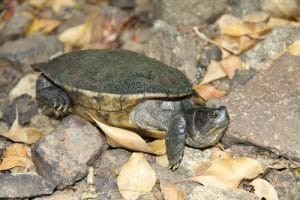Trachemys yaquia (Yaqui Slider)
Home > Turtle Database > Trachemys yaquia (Yaqui Slider)

Trachemys yaquia, or the Yaqui Slider, is a freshwater turtle native to northern Mexico. It’s a close relative of the red-eared slider but lives in a much more limited range. This species is quite shy and depends heavily on clean, slow-moving waters.
Native Turtle Species Map – Find Turtles by Region
Scientific Classification
Kingdom: Animalia
Phylum: Chordata
Class: Reptilia
Order: Testudines
Family: Emydidae
Genus: Trachemys
Species: Trachemys yaquia
Common Names
Yaqui Slider
Yaquia Slider Turtle
This Hilarious Turtle Book Might Know Your Pet Better Than You Do
Let’s be real—most turtle care guides feel like reading a textbook written by a sleep-deprived zookeeper.
This one’s not that.
Told from the snarky point of view of a grumpy, judgmental turtle, 21 Turtle Truths You’ll Never Read in a Care Guide is packed with sarcasm, sass, and surprisingly useful insights.
And hey—you don’t have to commit to the whole thing just yet.
Grab 2 free truths from the ebook and get a taste of what your turtle really thinks about your setup, your food choices, and that weird plastic palm tree.
It’s funny, it’s honest, and if you’ve ever owned a turtle who glares at you like you’re the problem—you’ll feel seen.
Identification
Description
The Yaqui Slider has an olive to dark green carapace, often with faint yellow or orange patterns. The plastron is lighter and may have dark blotches. Its head and limbs show yellow stripes similar to other Trachemys species.
Sexual Dimorphism
Males are smaller with longer front claws and a longer, thicker tail. Females are larger and broader with a shorter tail and smaller claws.
Check more turtles from the Trachemys genus
Native Origin and Distribution
Geographical Range
This turtle is native to the Yaqui River basin in the Mexican states of Sonora and Chihuahua. Its range is highly localized and does not extend into the United States.
Preferred Habitat
The Yaqui Slider prefers slow-moving rivers, streams, ponds, and canals. It thrives in areas with soft, muddy bottoms and plenty of aquatic vegetation for food and cover. Basking sites like logs or rocks are also important.
Behavior
Feeding Habits
It is an omnivore. Young sliders eat more insects and small aquatic animals, while adults shift toward a more plant-based diet.
Predators
Predators include raccoons, birds of prey, large fish, and humans. Eggs and hatchlings are especially vulnerable.
Reproduction
Breeding Season
Mating usually occurs during the warmer months, mostly between spring and early summer.
Reproductive Method
The female lays several eggs in a nest dug into soft soil. After incubation, hatchlings emerge and head for the water. Like other sliders, sex is determined by nest temperature.
Conservation
Extinction Status
Listed as Vulnerable on the IUCN Red List.
Threats
Habitat destruction, water pollution, and competition or hybridization with non-native turtles like the red-eared slider are major threats.
Conservation Measures
Protected areas have been set up in parts of its range. Awareness efforts and habitat restoration projects are ongoing, though enforcement is often limited.
Economic Importance
This turtle has little economic value. It’s not commonly sold in the pet trade or consumed, though it may be locally collected. Its presence is more important for local biodiversity and ecosystem health.
Interesting Facts
It is one of the least known sliders in the Trachemys genus.
Because of its limited range, it’s rarely seen outside of scientific research.
Unlike many turtles, it hasn’t adapted well to disturbed or urbanized environments.

About Author
Muntaseer Rahman started keeping pet turtles back in 2013. He also owns the largest Turtle & Tortoise Facebook community in Bangladesh. These days he is mostly active on Facebook.














